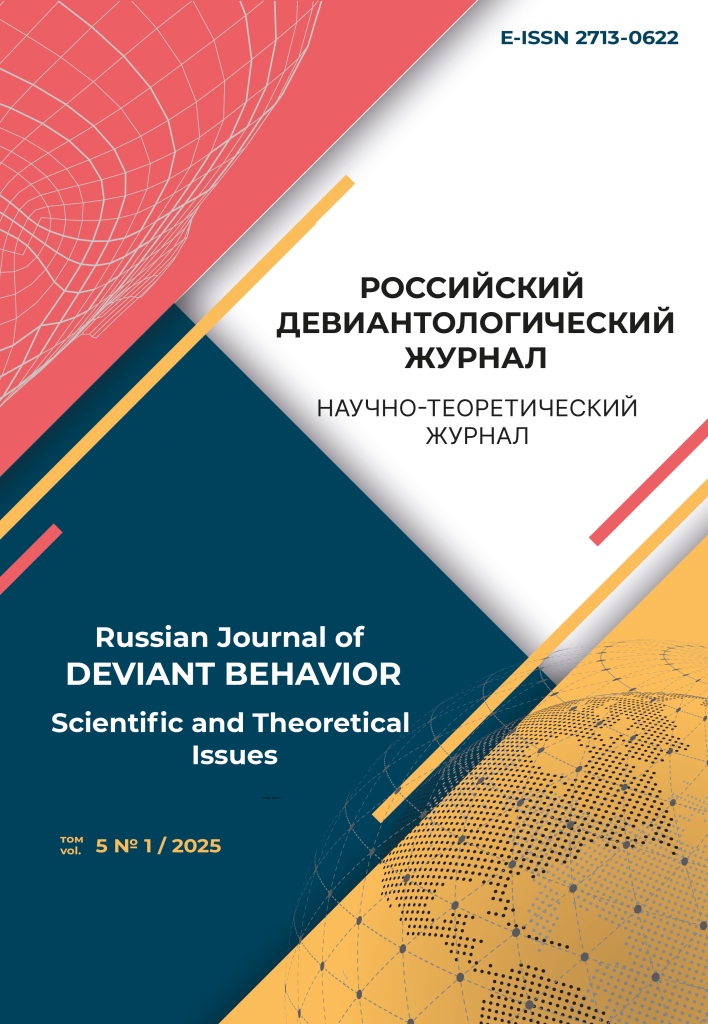УДК 159.99 Прочие вопросы психологии
Стремительное развитие цифровых технологий меняет сознание и образ жизни людей, предоставляя им большие возможности. В то же время, являясь виртуальным пространством, параллельным реальному миру, потенциальные риски интернета становятся все более заметными, особенно для такой уязвимой аудитории, как подростки. Подростки, чья психология и личность еще не созрели, легко поддаются влиянию негативных факторов в интернет-среде, что может привести к девиантному поведению в сети «Интернет». Благополучно развиваться в эпоху современных технологий и не поддаваться воздействию негативной информации – не просто право подрастающего поколения, но и обязанность, возложенная законом на общество. Анализируя механизм формирования девиантного поведения подростков в сети «Интернет» с психологической точки зрения, следует определить эффективные решения для профилактики и коррекции их неправомерного поведения, а также обеспечить им здоровое и безопасное развитие в век цифровых технологий.
психология, подростки, онлайн, девиантное поведение, превентивные стратегии
1. Deng, X. (2008). Internet victimization of adolescents from the perspective of criminology and its prevention. Journal of Wuhan Economic Management Cadre College, 22 (4), 32–36.
2. Feng, T. (2023). Analysis of the influencing factors and paths of minor Internet addiction. Chinese Youth Social Sciences, 3.
3. Guo, Y., & Wang, H. (2010). Analysis of Juvenile Internet Misconduct. Juvenile Crime Issues, (3), 75–79.
4. Han, J. (2007). The Impact of the Internet on Adolescents and Countermeasures. Youth Crime Research, (5), 65–67.
5. Henry, N., & Powell, A. (2018). Technology-Facilitated Sexual Violence: A Literature Review of Empirical Research. Trauma Violence Abuse, 19 (2), 195–208. https://doi.org/10.1177/1524838016650189
6. Hoeben, E. M., Meldrum, R. C., Walker, D'A., & Young, J. T. N. (2016). The role of peer delinquency and unstructured socializing in explaining delinquency and substance use: A state-of-the-art review. Journal of Criminal Justice, 47, 108–122. https://doi.org/10.1016/j.jcrim-jus.2016.08.001
7. Hu, J. (2008). A Brief Discussion on Online Moral Education for Adolescents. Journal of Hubei University of Economics (Humanities and Social Sciences Edition), 5 (6).
8. Huang, H., & Jin, D. (2006). The Internet Environment and the Legal and Ethical Awareness of Adolescents. Juvenile Crime Issues, (6), 39–42.
9. Jin, B. (2014). Prevention and Correction of Internet Misconduct among College Students from the Perspective of Social Work. Theoretical Observation, (03).
10. Jorgensen, T. D., Forney, K. J., Hall, J. A., & Giles, S. (2018). Using Modern Methods for Missing Data Analysis with the Social Relations Model: A Bridge to Social Network Analysis. Soc Networks, 54, 26–40. https://doi.org/10.1016/j.socnet.2017.11.002
11. Kang, C. (2010). On Network Culture and Its Impact on Adolescents. Journal of Taiyuan City Vocational and Technical College, (11).
12. Lewis, K., & Papachristos, A. V. (2020). Rules of the Game: Exponential Random Graph Models of a Gang Homicide Network. Social Forces, 98 (4), 1829–1858. https://doi.org/10.1093/sf/soz106
13. Liu, Y. (2007). The causes and solutions of contemporary Chinese social deviance issues: insights from reading Merton's deviant theory. Journal of Northeastern University of Finance and Economics, (2), 82–85
14. Liu, T.-H., Ma, Z., & Xia, Y. (2021). Cyberbullying-Victimization Overlap Among Chinese University Students: Does Network Structure Matter? Crime & Delinquency, 68 (13-14), 2581–2601. https://doi.org/10.1177/00111287211057856
15. Lu, B., Sun, H., Harris, P., Xu, M., & Charlton, M. (2018). Shp2graph: Tools to Convert a Spatial Network into an Igraph Graph in R. ISPRS International Journal of Geo-Information, 7 (8), 293. https://doi.org/10.3390/ijgi7080293
16. Mamun, A-A., Aseltine, R., & Rajasekaran, S. (2015). RLT-S: A Web System for Record Linkage. PLoS ONE. https://doi.org/10.1371/journal.pone.0124449
17. Prevention and treatment of bullying and violence in primary and middle school students (2018). The Department of Basic Education, the Ministry of Education. Beijing: Education Science Press.
18. Shi, G., Zheng, X., & Tang, J. (2021). The impact mechanism of leadership humor on employee interpersonal deviant behavior. Journal of Capital University of Economics and Trade, (4), 77–86.
19. Wang, R. (2003). Causes and Countermeasures of Juvenile Delinquency. Journal of Xi'an University of Finance and Economics, 16 (4), 62–64.
20. Xu, B., Xia, Y., Zhou, Y., & Zhang, Y. (2023). The relationship between adolescent online deviant behavior and negative peers: A method based on social network analysis. Youth Research, (01).
21. Yang, X. (2014). Effect of violent video games on individual empathy and prosocial behavior tendencies. Hunan: Hunan Normal University.
22. Zang, G. (2013). A review of the social regulatory factors influencing juvenile delinquency by deviant peers. Juvenile Crime Issues, (5), 105–109.
23. Zhang, A., & Sun, Y. (2010). Exploring the Causes and Countermeasures of Juvenile Delinquency in China from the Perspective of Marginality. Journal of Hubei University of Economics (Humanities and Social Sciences Edition), 7 (4), 72–73.
24. Zhao, X. (2008). Online Media and Youth Values Education. Journal of Shanxi Economic and Management Cadre College, 16 (1), 60–62.
25. Zheng, Y., Zhang, Y., & Gao, G. (2009). Research on adolescent mental health education in the online environment. Journal of Shaanxi Provincial School of Administration and Shaanxi Provincial School of Economic Management Cadres, (4), 22–25.
26. Zheng, R., Liu, M., & Chen, Z. (2022). Workplace Infringement from the Perspective of "Power": An Empirical Analysis Based on CGSS2015 Data. Sociological Research, (05).
27. Zuo, J., & Li, J. (2014). Research on adolescent Internet devbehavior from a sociological perspective. Journal of Hubei University of Economics (Humanities and Social Sciences edition), 8, 30–32.













